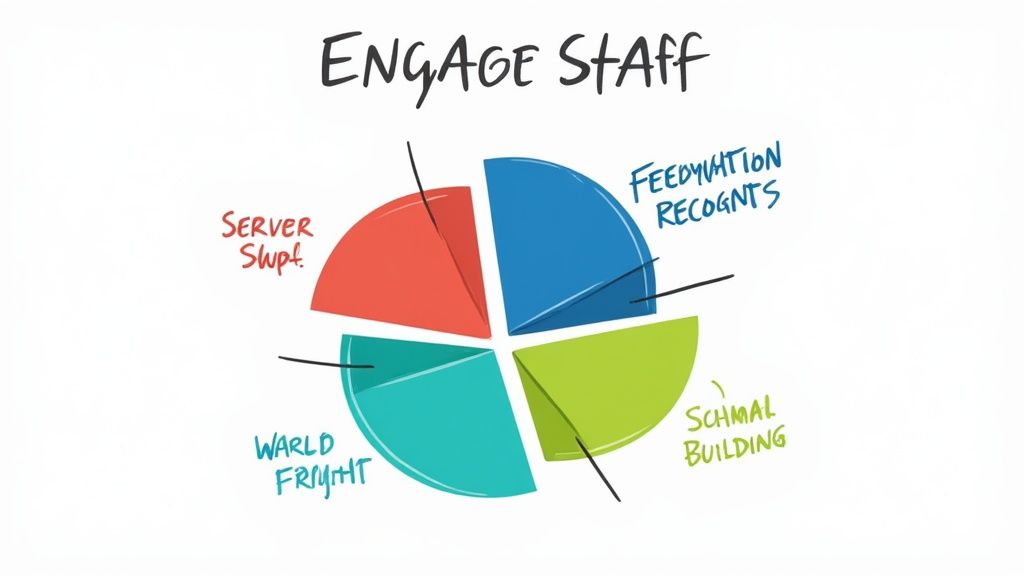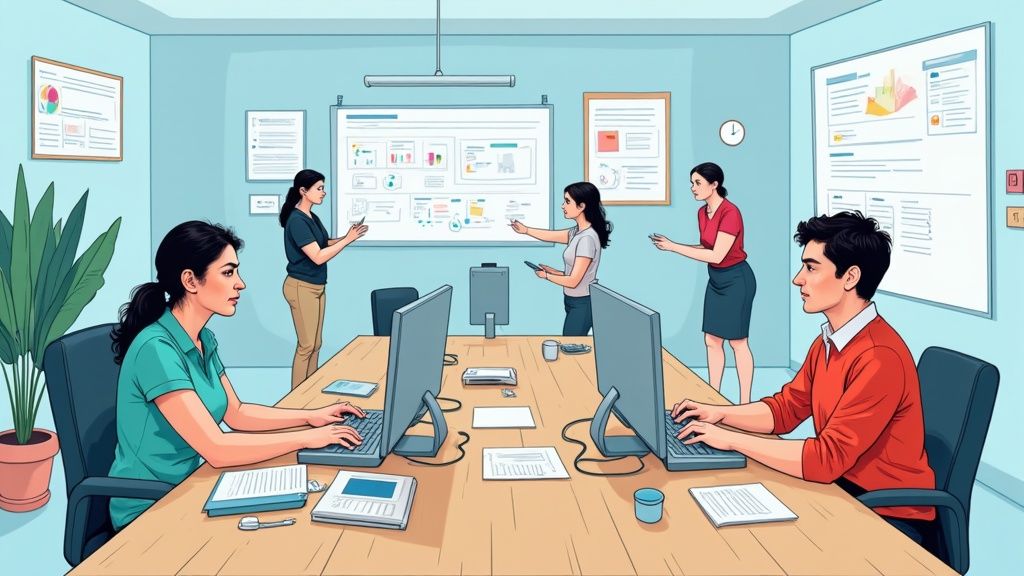How to Increase Staff Engagement: 7 Proven Strategies That Drive Results

The Business Impact of Employee Engagement
When employees are truly engaged at work, it creates benefits that go far beyond just having a more positive workplace. Teams that are invested in their roles and align with company goals generate real, measurable value across the organization.
Profitability and Sales Growth
The numbers tell a compelling story about why engagement matters for business success. Teams with high engagement deliver impressive financial results – studies show these companies see a 23% boost in profits and 18% higher sales compared to those with lower engagement. See the full engagement statistics. This clear connection between engaged teams and better financial performance makes a strong case for investing in employee engagement.
Enhanced Customer Satisfaction
Happy, engaged employees provide better service and create more satisfied customers. When staff members feel motivated and valued, they put in the extra effort to solve problems and exceed expectations. This improved customer experience builds loyalty and drives repeat business. The quality of employee engagement directly shapes how customers view and interact with your brand.
Innovation and Productivity
Engaged teams are more likely to contribute fresh ideas and creative solutions that move the business forward. They spot opportunities for improvement and actively work to make processes better. This creates a positive cycle – when employees see their ideas making an impact, they become even more invested in the company's success. The result is both higher productivity and a constant stream of innovations that help the business grow and adapt.
Setting Clear Expectations and Growth Paths

Engaging employees starts with giving them a clear picture of their role and opportunities to grow. When team members understand exactly what they need to do and how their work matters, they become more invested in their jobs. This understanding forms the building blocks of a truly engaged workforce.
Defining Crystal-Clear Roles and Responsibilities
Unclear job roles can quickly lead to disengaged employees. That's why spelling out responsibilities in detail makes such a difference. When people know exactly what's expected, they can take ownership of their work with confidence. Think of it like a road map – when everyone knows their route, the journey becomes smoother.
- Write Everything Down: Keep detailed records of expectations, KPIs, performance goals, and reporting lines that employees can easily access and review
- Meet One-on-One Often: Schedule regular check-ins between managers and team members to discuss progress, share feedback, and address questions
- Keep Communication Open: Build a workplace where people feel comfortable asking questions and seeking clarity when needed
With clear expectations in place, employees can focus on doing great work. This foundation of understanding opens the door for growth opportunities.
Creating Inspiring Career Pathways
Recent data from Gallup shows that only 45% of younger workers fully understand what's expected of them at work – down seven points from 2020 levels. This lack of clarity has contributed to employee engagement hitting an 11-year low in the U.S. To combat this trend, companies need to focus on both clear expectations and growth opportunities.
- Offer Learning Programs: Create training that helps employees build skills aligned with their career goals and the company's needs
- Start Mentoring: Connect experienced staff with newer team members to share knowledge and support professional development
- Review Progress Regularly: Schedule performance discussions that celebrate wins and identify specific steps for career advancement
When organizations consistently communicate expectations, provide feedback, and create paths for growth, employees feel valued and supported. This investment leads to higher motivation and engagement, creating a more positive work environment. The next step is establishing strong communication channels to keep this momentum going.
Building Effective Communication Channels

Clear and regular communication forms the foundation of an engaged workforce. When done right, it creates meaningful connections between team members and builds a strong company culture. Let's explore practical ways companies can develop communication strategies that help employees feel valued and connected.
Creating a Multi-Channel Communication Strategy
Different employees prefer different ways of receiving information. That's why successful companies use multiple communication channels rather than relying solely on email. Some effective options include:
- Team chat apps for quick updates
- Company intranet for important documents
- Video calls for face-to-face meetings
- Digital bulletin boards for announcements
This mix of channels helps ensure messages reach everyone, regardless of their work style or location.
Implementing Effective Feedback Systems
Good communication goes both ways. Companies need clear systems for employees to share their thoughts and concerns. Some proven approaches include:
- Quick pulse surveys
- Anonymous feedback forms
- Regular one-on-one meetings
- Suggestion boxes (physical or digital)
The key is making feedback easy to give and showing that leadership takes it seriously. When companies act on employee input, it builds trust and encourages more open dialogue.
Research shows the impact of strong communication – 85% of employees report feeling more motivated when communication is clear and consistent. Companies with engaged employees also see 41% lower absenteeism rates. See the full research from HR Cloud.
Designing Engaging Town Hall Meetings
Company-wide meetings work best when they encourage participation rather than one-way presentations. Some ways to make town halls more engaging:
- Start with a brief update, then open for questions
- Use live polling during the session
- Collect questions beforehand
- Follow up on key discussion points
- Record sessions for those who can't attend
This approach helps build community and gives employees direct access to leadership.
Utilizing Digital Tools to Connect Teams
The right tools can greatly improve how teams communicate and work together. For example, Supportman helps teams share customer feedback efficiently. Project management tools keep everyone aligned on goals and deadlines. When chosen thoughtfully, these tools can:
- Speed up information sharing
- Reduce email overload
- Help remote teams stay connected
- Make collaboration easier
- Track project progress clearly
The focus should be on picking tools that fit your team's needs and work patterns rather than following trends.
Using Technology to Drive Staff Engagement
The right digital tools can make a huge difference in keeping employees connected and engaged. When used well, technology helps teams communicate better, work more efficiently, and feel more satisfied in their roles. Let's explore practical ways to use technology that truly helps your staff stay engaged and productive.
Choosing the Right Tools for Your Team
Before investing in new tech tools, consider how they'll specifically help your team engage better. Key questions to ask:
- Will this make it easier for people to communicate and work together? For example, Slack or Microsoft Teams for quick chats, or Asana for keeping projects organized.
- Can this support employee wellbeing? Think mental health apps or wellness program platforms.
- Does this remove tedious busywork so people can focus on meaningful tasks? Look for tools with simple interfaces and automated features.
Taking time to answer these questions helps you pick tools that your team will actually want to use, rather than ones that just create more frustration.
Making Different Tools Work Together
Most companies use several different platforms for various tasks. The trick is getting them to work together smoothly so they help rather than hinder your team's engagement.
- Create One Central Hub: Give employees a single place to access all their tools
- Connect Your Tools: Set up automatic connections between different platforms
- Make It Clear: Help everyone understand which tool to use when
When your digital tools work together seamlessly, people spend less time wrestling with technology and more time doing work that matters.
Better Ways to Recognize and Connect
Digital platforms offer great opportunities for showing appreciation and working together effectively. They make it easy to give quick feedback, recognize good work, and keep in touch with teammates. Research shows that wellness programs supported by technology can reduce employee absences by 25% and boost overall wellbeing. Learn more about engagement trends on Blink's research page. Digital platforms also help remote teams collaborate on projects, share ideas, and support each other, no matter where they're located.
Keeping Things Personal
While technology is valuable, it shouldn't replace human connections. Make sure to balance digital tools with in-person meetings, team activities, and casual social time. The best results come from using technology to strengthen real human relationships, not replace them. This combination of digital convenience and personal connection creates an environment where people feel truly engaged and supported.
Creating a Culture of Recognition and Appreciation

Making employees feel valued is key to boosting engagement at work. When team members know their contributions matter, they naturally become more motivated and committed. This creates an energetic workplace where people want to do their best.
Understanding the Psychology of Recognition
Good recognition means more than just saying thanks. People are motivated by different things – some love public praise while others prefer a quiet word of appreciation. Some value tangible rewards, while others care more about chances to learn and grow. The secret is matching your approach to what matters most to each person. This personal touch makes recognition feel real and meaningful.
Building a Formal Recognition Program
Having set ways to recognize achievements helps make appreciation consistent. Strong programs often include:
- Employee-of-the-Month Awards: Spotlighting standout work each month
- Performance-Based Bonuses: Rewarding great results with extra compensation
- Anniversary Celebrations: Making milestone moments special
- Peer Recognition: Letting coworkers highlight each other's great work
These structured programs show that recognizing good work is a real priority.
The Power of Informal Recognition
While formal programs matter, day-to-day appreciation is just as important. Small gestures like saying thanks, writing a quick note, or giving a shoutout in meetings can make someone's day. Simple tools like Supportman help teams instantly share positive customer feedback. Making recognition a natural part of daily work strengthens team bonds and keeps people motivated.
Training Leaders to Give Meaningful Appreciation
For recognition to work, it needs to be genuine. Good leaders know how to show real appreciation by:
- Being specific about what someone did well
- Showing how their work helped the team or company
- Personalizing recognition to what matters to each person
When leaders give thoughtful recognition, it sets the tone for everyone else. Their example creates a ripple effect of appreciation across teams. Building this culture of recognition helps create an environment where people feel valued, motivated and ready to do their best work.
Measuring and Maintaining Engagement Success

Building staff engagement is like growing a garden – it needs consistent care and attention to flourish. Success requires both measuring progress and adjusting your methods based on what works. This section shows you how to gather meaningful data and turn it into real improvements that last.
Identifying and Tracking Key Engagement Metrics
Choose metrics that directly show how engaged your team really is. While standard surveys help, focus on numbers that connect to business results:
- Turnover Rate: Track how many people leave – high turnover often means low engagement
- Absenteeism: Engaged teams have 78% fewer absences than disengaged ones
- Productivity: Look at whether teams meet their goals consistently
- Customer Satisfaction: Happy, engaged employees tend to create happier customers
- Employee Net Promoter Score: Measures if staff would recommend working at your company
Watch these numbers over time to see if your engagement efforts make a difference.
Conducting Effective Engagement Surveys
Regular feedback helps you understand how your team feels. Make your surveys count by:
- Asking Clear Questions: Focus on specific areas like communication quality or growth opportunities
- Keeping It Short: Brief surveys get better participation
- Ensuring Privacy: Anonymous feedback tends to be more honest
- Taking Action: Show you care by making changes based on responses
These steps turn basic surveys into valuable tools for positive change.
Analyzing Feedback Patterns and Implementing Changes
Look for common themes in your survey results. What issues come up most often? Where do people struggle? Use these insights to make targeted fixes. For example, if teams mention communication gaps, try tools like Supportman to help everyone share information more easily. Remember that improvement takes time – keep checking your metrics, trying new approaches, and talking with your team.
Maintaining Momentum and Adapting Strategies
Just as gardens need regular care, engaged teams need ongoing attention. Celebrate wins, face challenges openly, and keep asking for input. This shows your team that their voice matters. Be ready to change course when needed – what worked before might not work now. Stay open to new ideas and keep learning from your results.
Ready to improve how your team connects and shares feedback? Try Supportman today and see the difference clear communication makes. Start your free trial now – no credit card needed!
What to do next
Whenever you're ready, here's three ways we can help you scale your support org:
- Claim your free Support Manager Handbook. It's a free 30+ page guide filled with strategies, tactics, and best practices for scaling your support org. Download it here.
- Subscribe to our Support Ops newsletter to get the latest updates here.
- Set up Internal Documentation with Tettra to start automatically answering the questions you get in Slack. Here's how.

